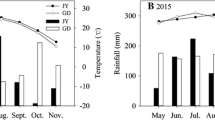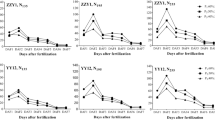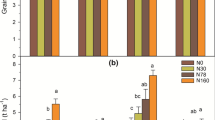Abstract
Currently, the urgency of balancing rice production and environmental risk from nitrogen (N) fertilization is gaining scientific and public attention. As such, a field experiment was conducted to investigate the rice yield and the fate of applied-15N for Yangliangyou 6 (a two-line hybrid cultivar) and Lvdaoq 7 (an inbred cultivar) using 10 combinations of N rates and splitting ratios in the middle reaches of the Yangtze River. The results showed that N application primarily affected fertilizer N loss to the environment, followed by plant N absorption, but had little effect on grain yield. Generally, there was no significant increase in grain yield and N accumulation in the aboveground plant when N inputs surpassed 130 or 170 kg ha−1. Fertilizer N residue in soil peaked at approximately 48 kg ha−1 at an N rate of 170 kg ha−1 for both varieties; however, a sharp increase of fertilizer N loss occurred with further incrementally increasing N rates. Although a higher ratio of panicle-N fertilizer together with a lower ratio of tillering-N fertilizer at rates of 130, 170, and 210 kg ha−1 had no grain yield benefit, it promoted aboveground N accumulation and plant N accumulation derived from fertilizer, and it reduced the amount of N residue in soil and N loss to the environment. Overall, reducing tillering-N ratios and increasing panicle-N ratios at an N rate between 130 and 170 kg ha−1 using fertilizer rates of 90–0–40 kg ha−1 and 90–40–40 kg ha−1 N at basal-tillering-panicle initiation stages could reduce the adverse environmental risks of chemical N from rice production without sacrificing rice yield.




Similar content being viewed by others
References
Bell M, Schwenke G, Lester D (2016) Understanding and managing N loss pathways. Australian Government, Grains Research and Development Corporation. https://grdc.com.au/resources-and-publications/grdc-update-papers/tab-content/grdc-update-papers/2016/02/understanding-and-managing-n-loss-pathways. Accessed 23 Feb 2016
Cao Y-S, Yin B (2015) Effects of integrated high-efficiency practice versus conventional practice on rice yield and N fate. Agric Ecosyst Environ 202:1–7
Chen X-P et al (2014) Producing more grain with lower environmental costs. Nature 514:486–489. https://doi.org/10.1038/nature13609
Chen Y-T et al (2015) Crop management based on multi-split topdressing enhances grain yield and nitrogen use efficiency in irrigated rice in China. Field Crop Res 184:50–57. https://doi.org/10.1016/j.fcr.2015.09.006
Cui Z-L et al (2014) Closing the N-use efficiency gap to achieve food and environmental security. Environ Sci Technol 48:5780–5787. https://doi.org/10.1021/es5007127
Dobermann A et al (2002) Site-specific nutrient management for intensive rice cropping systems in Asia. Field Crop Res 74:37–66. https://doi.org/10.1016/S0378-4290(01)00197-6
Han X-Z, Wang S-Y, Song C-Y, Qiao Y-F (2003) Fate of fertilizer nitrogen in paddy field of black soil region. Chin J Appl Ecol 14(11):1859–1862
Han B-J et al (2012) Evaluation and present situation of fertilization for rice in Hubei province. Hubei Agric Sci 51:2430–2435 (in Chinese with English abstract)
Hofmeier M et al (2015) Nitrogen management in a rice-wheat system in the Taihu Region: recommendations based on field experiments and surveys. Agric Ecosyst Environ 209:60–73. https://doi.org/10.1016/j.agee.2015.03.032
Huang J-B et al (2007) Investigation on the economically-ecologically appropriate amount of nitrogen fertilizer applied in rice production in Fe-leaching-Stagnic Anthrosols of the Taihu Lake region. Acta Ecol Sin 27(2):0588–0595
Huang J-L et al (2008) Determination of optimal nitrogen rate for rice varieties using a chlorophyll meter. Field Crop Res 105:70–80. https://doi.org/10.1016/j.fcr.2007.07.006
Jenkinson DS et al (1985) Interactions between fertilizer nitrogen and soil nitrogen—the so-called ‘priming’ effect. J Soil Sci 36(3):425–444. https://doi.org/10.1111/j.1365-2389.1985.tb00348.x
Ju X-T, Zhang F-S (2003) Thinking about nitrogen recovery rate. Ecol Environ 12:192–197 (in Chinese with English abstract). https://doi.org/10.3969/j.issn.1674-5906.2003.02.018
Ju X-T et al (2009) Reducing environmental risk by improving N management in intensive Chinese agricultural systems. PNAS 106(9):3041–3046. https://doi.org/10.1073/pnas.0813417106
Kadiyala MDM et al (2014) Uptake efficiency of 15N-urea in flooded and aerobic rice fields under semi-arid conditions. Paddy Water Environ. https://doi.org/10.1007/s10333-014-0473-8
Ladha JK, Pathak H, Krupnik TJ, Six J, van Kessel C (2005) Efficiency of fertilizer nitrogen in cereal production: retrospect and prospects. Adv Agron 87:85–156
Leon M et al (1995) Increased uptake of native soil nitrogen by roots of Lolium multiflorum Lam. after nitrogen fertilization is explained by a stimulation of the uptake process itself. Plant Soil 173:197–203
Li J-J et al (2015a) Evolution characteristics of soil nutrients in the main rice production regions, the middle-lower reach of Yangtze River of China. J Plant Nutr Fert 21(1):92–103 (in Chinese with English abstract). https://doi.org/10.11674/zwyf.2015.0110
Li Y et al (2015b) Evaluation of nitrogen balance in a direct-seeded-rice field experiment using Hydrus-1D. Agric Water Manag 148:213–222. https://doi.org/10.1016/j.agwat.2014.10.010
Li P-F, Li X-K, Hou W-F, Ren T, Cong R-H, Du C-W, Xing L-H, Wang S-H, Lu J-W (2018) Studying the fate and recovery efficiency of controlled release urea in paddy soil using 15N tracer technique. Sci Agric Sin 51(20):3961–3971 http://manu71.magtech.com.cn/zgnykx/CN/10.3864/j.issn.0578-1752.2018.20.014
Lin S et al (2004) Added nitrogen interaction as affected by soil nitrogen pool size and fertilization-significance of displacement of fixed ammonium. J Plant Nutr Soil Sci 167:138–146
Lin J, Li G, Xue L, Zhang W, Xu H, Wang S, Yang L, Ding Y (2014) Subdivision of nitrogen use efficiency of rice based on 15N tracer. Acta Agron Sin 40:1424–1434 (in Chinese with English abstract). https://doi.org/10.3724/SP.J.1006.2014.01424
Mikkelsen DS (1987) Nitrogen budgets in flooded soils used for rice production. Plant Soil 100:71–97. https://doi.org/10.1007/BF02370933
Norman R et al (2013) Nitrogen uptake efficiency of a hybrid compared with a conventional, pure-line rice cultivar. Soil Sci Soc Am J 77:1235–1240. https://doi.org/10.2136/sssaj2013.01.0015
Pan S-G et al (2012) Effects of N management on yield and N uptake of rice in central China. J Integr Agric 11(12):1993–2000
Peng S, Cassman KG (1998) Upper thresholds of nitrogen uptake rates and associated nitrogen fertilizer efficiencies in irrigated rice. Agron J 90:178–185. https://doi.org/10.2134/agronj1998.00021962009000020010x
Peng S et al (2002) Research strategy in improving fertilizer-nitrogen use efficiency of irrigated rice in China. Sci Agric Sin 35:1095–1103 (in Chinese with English abstract). https://doi.org/10.3321/j.issn:0578-1752.2002.09.012
Peng S et al (2006) Strategies for overcoming low agronomic nitrogen use efficiency in irrigated rice systems in China. Field Crop Res 96:37–47. https://doi.org/10.1016/j.fcr.2005.05.004
Salvagiotti, Miralles (2008) Radiation interception, biomass production and grain yield as affected by the interaction of nitrogen and sulfur fertilization in wheat. Eur J Agron 28(3):282–290. https://doi.org/10.1016/j.eja.2007.08.002
Sui B et al (2013) Optimizing nitrogen supply increases rice yield and nitrogen use efficiency by regulating yield formation factors. Field Crop Res 150:99–107. https://doi.org/10.1016/j.fcr.2013.06.012
Takahashi S, Yagi A (2002) Losses of fertilizer-derived N from transplanted rice after heading. Plant Soil 242:245–250. https://doi.org/10.1023/A:1016262122991
Tian Y-H, Yin B, He F-Y, Zhu Z-L (2009) Recovery by crop and loss of nitrogen fertilizer applied in rice season in Taihu Lake region. J Plant Nutr Fert 15(1):55–61 (in Chinese with English abstract). https://doi.org/10.3321/j.issn:1008-505X.2009.01.008
Uchida R, Hue N V (2000) Soil acidity and liming. In: Silva JA, Uchida R (eds) Plant nutrient management in Hawaiian soils, approaches for tropical and subtropical agriculture, College of Tropical Agriculture and Human Resources, University of Hawaii, Manoa, pp 101–111. http://hdl.handle.net/10125/1908
Wang D-Y et al (2017) 15N tracer-based analysis of genotypic differences in the uptake and partitioning of N applied at different growth stages in transplanted rice. Field Crop Res 211:27–36
Wang M, Yang J-P, Xv W, Wang H, Sun J-H (2009) Influence of nitrogen rates with split application on N use efficiency and its eco-economic suitable amount analysis in rice. J Zhejiang Univ, Agric Life Sci 35(1):71–76 (in Chinese with English abstract). https://doi.org/10.3785/j.issn.1008-9209.2009.01.010
Wilson CE, Norman RJ, Wells BR (1989) Seasonal uptake patterns of fertilizer nitrogen applied in split applications to rice. Soil Sci Soc Am J 53:1884–1887. https://doi.org/10.2136/sssaj1989.03615995005300060045x
Yan J, Yin B, Zhang S-L, Shen Q-R, Zhu Z-L (2008) Effect of nitrogen application rate on nitrogen uptake and distribution in rice. J Plant Nutr Fert 14(5):835–839. https://doi.org/10.3321/j.issn:1008-505X.2008.05.003
Yan J, Shen Q-R, Yin B, Wan X-J (2009) Fertilizer-N uptake and distribution in rice plants using 15N tracer technique. J Nucl Agric Sci 23:487–491 (in Chinese with English abstract). http://d.oldg.wanfangdata.com.cn/Periodical_hnxb200903026.aspx
Yang L et al (2013) Effects of reducing N application on crop N uptake, utilization and soil N balance under rice-wheat rotation system on middle and lower reaches of Yangtze River Region. Southwest China J Agric Sci 26(1):195–202 (in Chinese with English abstract). https://doi.org/10.16213/j.cnki.scjas.2013.01.007
Ying J-F, Peng S-B, He Q-G, Yang H, Yang C-D, Visperas RM, Cassman KG (1998) Comparison of high-yield rice in tropical and subtropical environments. I Determinants of grain and dry matter yields. Field Crop Res 57:71–84. https://doi.org/10.1016/s0378-4290(98)00077-x
Zhang Q-W et al (2010) The fate of fertilizer-derived nitrogen in a rice field in the Qingtongxia irrigation area. Acta Sci Circumst 30(8):1707–1714 (in Chinese with English abstract. https://doi.org/10.13671/j.hjkxxb.2010.08.023
Zhang H-C et al (2011) Precise postponing nitrogen application and its mechanism in rice. Acta Agron Sin 37(10):1837–1851 (in Chinese with English abstract). https://doi.org/10.3724/SP.J.1006.2011.01837
Zhang Q-W, Yang Z-L, Zhang H, Yi J (2012) Recovery efficiency and loss of 15N-labelled urea in a rice-soil system in the upper reaches of the Yellow River basin. Agric Ecosyst Environ 158:118–126. https://doi.org/10.1016/j.agee.2012.06.003
Zhang Z et al (2013) Mid-season nitrogen application strategies for rice varieties differing in panicle size. Field Crop Res 150:9–18. https://doi.org/10.1016/j.fcr.2013.06.002
Zhao X et al (2009) Nitrogen fate and environmental consequence in paddy soil under rice-wheat rotation in the Taihu lake region, China. Plant Soil 319:225–234. https://doi.org/10.1007/s11104-008-9865-0
Zhong X-H, Huang N-R, Zheng H-B (2007) Some principles for the “three controls” nutrient management technology for irrigated rice. Guangdong Agric Sci (5):19–22. https://doi.org/10.3969/j.issn.1004-874X.2007.05.005
Zhu Z-L (1997) Fate and management of fertilizer nitrogen in agro-ecosystems. In: Zhu Z-L, Wen Q-X, Freney JR (eds) Nitrogen in Soils of China. Developments in Plant and Soil Sciences 74:239–279. https://doi.org/10.1007/978-94-011-5636-3
Zhu Z-L (2008) Research on soil nitrogen in China. Acta Pedol Sin 45(5):778–783 (in Chinese with English abstract). https://doi.org/10.3321/j.issn:0564-3929.2008.05.003
Zou Y-B, Ao H-J, Wang S-H, Tang Q-Y (2006) Studies on San-Ding Cultivation Method for super rice: the concept and the principle. Chin Agric Sci Bull 22(5):158–162 (in Chinese with English abstract). https://doi.org/10.3969/j.issn.1000-6850.2006.05.043
Acknowledgments
Valuable suggestions given by Dr. Xiong D-L of College of Plant Science and Technology of Huazhong Agricultural University are also acknowledged.
Funding
This work was supported by a grant from the National Key Research and Development Program of China (No. 2016YFD0300210) and a grant from the National Natural Science Foundation of China (No. 31671620).
Author information
Authors and Affiliations
Contributions
Jianliang Huang and Jing Wang initiated and designed the research, Jing Wang, Penghao Fu, Yutiao Chen, and Congde Zhang performed the experiments, Jing Wang, Fei Wang, and Shah Fahad analyzed the data and wrote the manuscript, and Fei Wang, Shah Fahad, Pravat K. Mohapatra, Jianliang Huang, Shaobing Peng, Kehui Cui, Lixiao Nie, and Dongliang Xiong revised and edited the manuscript and also provided advices on the experiments.
Corresponding author
Ethics declarations
Conflict of interest
The authors declare that they have no conflict of interest.
Competing financial interests
The corresponding author on behalf of all coauthors, declare no competing financial interests.
Additional information
Responsible editor: Philippe Garrigues
Rights and permissions
About this article
Cite this article
Wang, J., Fu, P., Wang, F. et al. Optimizing nitrogen management to balance rice yield and environmental risk in the Yangtze River’s middle reaches. Environ Sci Pollut Res 26, 4901–4912 (2019). https://doi.org/10.1007/s11356-018-3943-5
Received:
Accepted:
Published:
Issue Date:
DOI: https://doi.org/10.1007/s11356-018-3943-5




